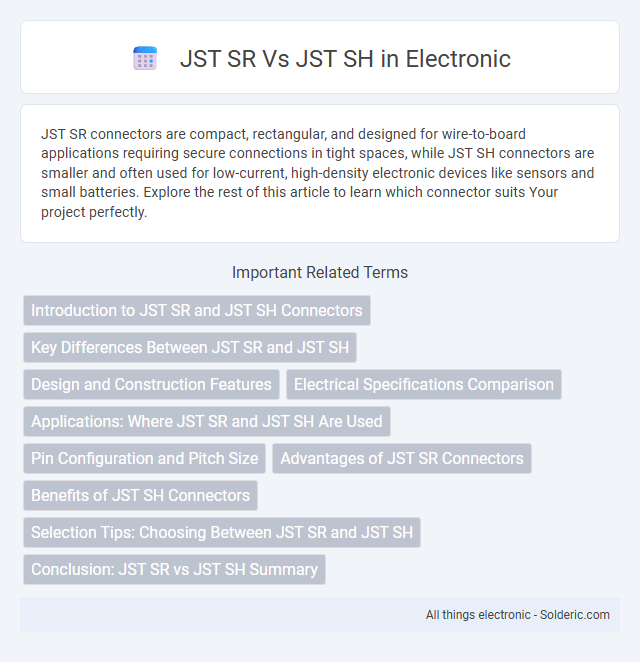JST SR connectors are compact, rectangular, and designed for wire-to-board applications requiring secure connections in tight spaces, while JST SH connectors are smaller and often used for low-current, high-density electronic devices like sensors and small batteries. Explore the rest of this article to learn which connector suits Your project perfectly.
Comparison Table
| Feature | JST SR Series | JST SH Series |
|---|---|---|
| Pitch | 2.5 mm | 1.0 mm |
| Contact Type | Crimp Socket | Crimp Socket |
| Application | Wire-to-Board, Wire-to-Wire | Wire-to-Board |
| Number of Positions | 2 to 24 | 2 to 10 |
| Connector Height | Mid-range height | Low-profile |
| Current Rating | 3A per contact | 1A per contact |
| Mounting Style | Through-Hole and Surface Mount | Surface Mount |
| Typical Use | General purpose connections | Compact electronic devices |
Introduction to JST SR and JST SH Connectors
JST SR and JST SH connectors are two widely used types of wire-to-board connectors known for their reliability and compact design in electronic applications. JST SR connectors feature a 2.5mm pitch, offering robust contact terminals suitable for power connections, while JST SH connectors provide a finer 1.0mm pitch ideal for high-density wiring in small devices. Choosing the right connector for your project depends on the spatial requirements and current capacity needed for optimal performance.
Key Differences Between JST SR and JST SH
JST SR connectors feature a 2.5 mm pitch and are commonly used for wire-to-board connections in compact electronics, while JST SH connectors offer a smaller 1.0 mm pitch suitable for high-density applications such as microcontrollers and wearable devices. The key differences include their pitch size, current rating--SR supports higher current up to 3 A compared to SH's typical maximum of 1 A--and overall connector size, impacting your choice based on space and power requirements. Selecting the right connector ensures optimal performance and reliability in your electronic designs.
Design and Construction Features
JST SR connectors feature a compact rectangular housing with crimp terminals designed for reliable wire-to-board connections in low-voltage applications, emphasizing ease of assembly and secure locking mechanisms. JST SH connectors offer a smaller pitch of 1.0mm and a slimmer profile, utilizing a similar locking system but optimized for high-density PCB arrangements and fine-pitch wiring. Both series employ high-quality nylon housings and gold-plated contacts to ensure durability and excellent electrical conductivity under various operational conditions.
Electrical Specifications Comparison
The JST SR series offers a maximum current rating of 7A with a contact resistance of 20mO, while the JST SH series supports currents up to 3A and a contact resistance of 30mO. Operating voltage for the SR connectors reaches up to 250V AC, compared to the SH series, which is typically rated for 100V AC. The SR series features thicker contacts and a larger pitch of 2.5mm, providing enhanced electrical performance over the SH series' 1.0mm pitch connectors designed for compact, low-power applications.
Applications: Where JST SR and JST SH Are Used
JST SR connectors are commonly found in compact electronic devices and consumer gadgets, offering reliable connections in limited-space environments such as drones and handheld instruments. JST SH connectors are preferred for applications requiring ultra-miniature, high-density connections, including wearable technology, medical devices, and small robotics. Your choice between JST SR and SH depends on the space constraints and the precision needed for the specific electronic assembly.
Pin Configuration and Pitch Size
JST SR connectors feature a 2.0mm pitch size suitable for compact electronic connections, while JST SH connectors have a finer 1.0mm pitch that supports high-density wiring applications. The JST SR pin configuration typically includes straight or right-angle pins designed for single-row connections, whereas JST SH connectors offer single-row, compact pin arrangements that maximize space efficiency. Understanding these differences ensures you select the right connector for your project's specific pin layout and spacing requirements.
Advantages of JST SR Connectors
JST SR connectors offer enhanced durability and vibration resistance compared to JST SH connectors, making them ideal for industrial and automotive applications. Their larger pin pitch supports higher current capacity and improved signal integrity in harsh environments. With a secure locking mechanism, JST SR connectors ensure reliable connections in demanding conditions where JST SH connectors may be less stable.
Benefits of JST SH Connectors
JST SH connectors offer compact design and reliable performance in tight spaces, making them ideal for small electronic devices and precision applications. Their fine pitch, typically 1.0mm, allows for higher density connections compared to JST SR connectors, enhancing your circuit's efficiency and reducing overall size. With secure locking mechanisms and excellent durability, JST SH connectors ensure stable electrical contacts and long-lasting connectivity in demanding environments.
Selection Tips: Choosing Between JST SR and JST SH
When selecting between JST SR and JST SH connectors, consider the pitch and application requirements--JST SR features a 2.5mm pitch ideal for PCB-to-cable connections with secure locking mechanisms, while JST SH offers a smaller 1.0mm pitch suitable for compact, high-density electronic devices. Assess your device's space constraints and current-carrying needs to ensure optimal performance and durability. Ensuring compatibility with your wiring harness and connector housings will streamline installation and improve overall system reliability.
Conclusion: JST SR vs JST SH Summary
JST SR connectors deliver a secure, high-density connection ideal for compact electronic devices with fine-pitch requirements, while JST SH connectors offer smaller and more delicate profiles suited for lightweight, space-constrained applications. SR series connectors feature a robust locking mechanism for enhanced durability, contrasting with the SH series' emphasis on ultra-compact design and ease of use in tight spaces. Both series provide reliable electrical connections, but the choice depends on the balance between size constraints and mechanical strength necessary for the specific application.
JST SR vs JST SH Infographic

 solderic.com
solderic.com